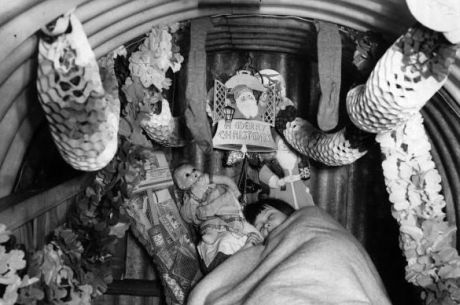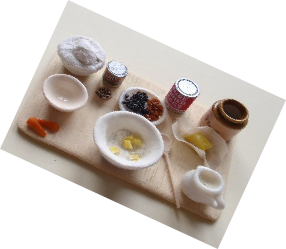Merry Gourmet Miniatures © 1988 - 2025 Designed By Bluechip Computer Support




|
A points system had been introduced for other groceries such as biscuits, jams,pulses,
tinned goods, dried fruit, jellies, custard powder and most other groceries. Each
individual was allowed 16 points a month. You needed all this for 1 can of meat,
fish or tinned fruit, but with the same amount of points you could get 2lbs of dried
fruit.But this might have to be made up of a combination of currants, raisins, sultanas,
figs, dates, or prunes. Many were the recipes for eggless cakes and being naturally sweet, grated carrots were heavily promoted as an addition to cakes and puddings to take the place of some of the sugar required. You were encouraged to add mashed potato to savoury scones or pastry so that you didn't have to use so much flour . Much use was made of baking powder as an additional raising agent.
Substitute icing was made with household milk powder, sugar and water. Quite effective at first but disappeared after a few hours, having soaked into the cake ! There was no white flour, only one grade called National Flour which had more bran
left in during the milling process to bulk up the product. This resulted in "heavier"
cakes and pastry which often meant its keeping quality was much reduced. Much home
baking relied on Dried Egg Powder which along with Spam was imported from America.
One packet or tin of Dried Egg was allowed per month, so it replaced fresh eggs in
recipes. All these restrictions taxed the housewife's ingenuity for day to day living, let alone putting aside for Christmas.Yet they coped magnificently in the main and usually managed to produce some extra treat when the occasion arose.Even though it may have tasted a bit odd, everybody was most appreciative of all the efforts they made to ensure that family and children had as good a time as conditions would allow. |

During the Second World War years, from January 1940 when food rationing was first introduced, celebrations had to be planned well in advance. Food rations were not over generous, by 1943 the weekly ration for one adult, was 4 ozs butter, 2 ozs margarine, 2 ozs lard, 8 ozs sugar, 2 ozs cheese, 2 ozs tea, 4 ozs bacon, 1/2d worth of meat and 1 fresh egg, if you were lucky.
A Wartime Christmas


